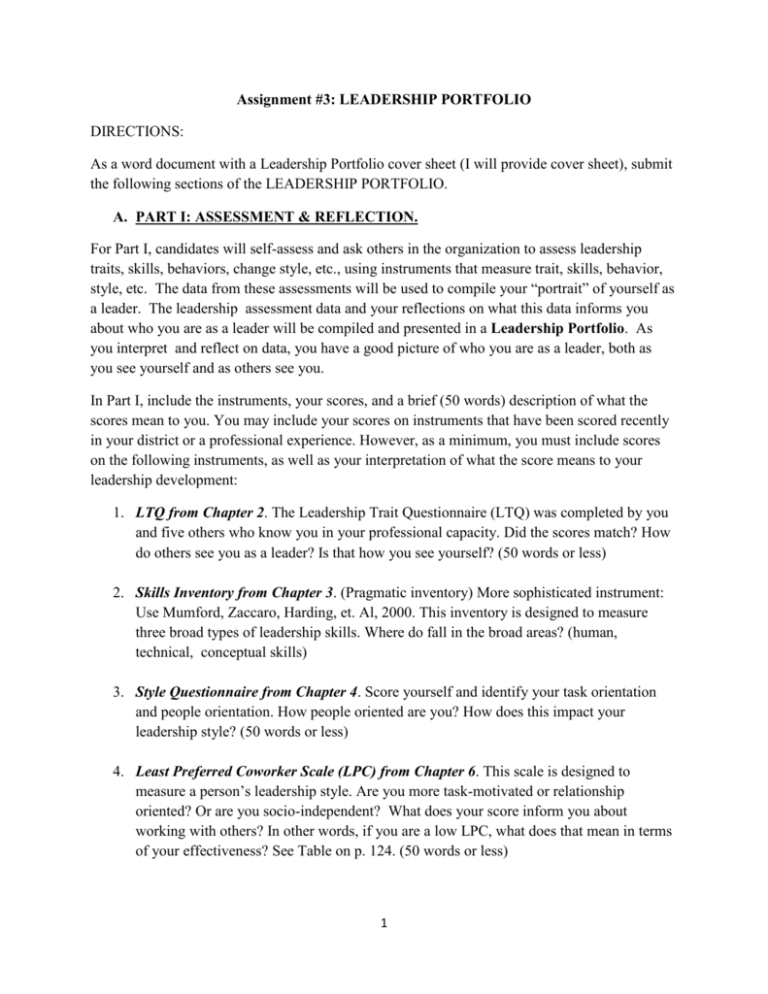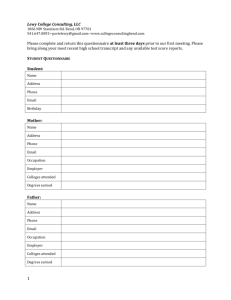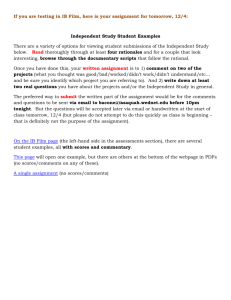Assignment # 3 Leadership Portoflio
advertisement

Assignment #3: LEADERSHIP PORTFOLIO DIRECTIONS: As a word document with a Leadership Portfolio cover sheet (I will provide cover sheet), submit the following sections of the LEADERSHIP PORTFOLIO. A. PART I: ASSESSMENT & REFLECTION. For Part I, candidates will self-assess and ask others in the organization to assess leadership traits, skills, behaviors, change style, etc., using instruments that measure trait, skills, behavior, style, etc. The data from these assessments will be used to compile your “portrait” of yourself as a leader. The leadership assessment data and your reflections on what this data informs you about who you are as a leader will be compiled and presented in a Leadership Portfolio. As you interpret and reflect on data, you have a good picture of who you are as a leader, both as you see yourself and as others see you. In Part I, include the instruments, your scores, and a brief (50 words) description of what the scores mean to you. You may include your scores on instruments that have been scored recently in your district or a professional experience. However, as a minimum, you must include scores on the following instruments, as well as your interpretation of what the score means to your leadership development: 1. LTQ from Chapter 2. The Leadership Trait Questionnaire (LTQ) was completed by you and five others who know you in your professional capacity. Did the scores match? How do others see you as a leader? Is that how you see yourself? (50 words or less) 2. Skills Inventory from Chapter 3. (Pragmatic inventory) More sophisticated instrument: Use Mumford, Zaccaro, Harding, et. Al, 2000. This inventory is designed to measure three broad types of leadership skills. Where do fall in the broad areas? (human, technical, conceptual skills) 3. Style Questionnaire from Chapter 4. Score yourself and identify your task orientation and people orientation. How people oriented are you? How does this impact your leadership style? (50 words or less) 4. Least Preferred Coworker Scale (LPC) from Chapter 6. This scale is designed to measure a person’s leadership style. Are you more task-motivated or relationship oriented? Or are you socio-independent? What does your score inform you about working with others? In other words, if you are a low LPC, what does that mean in terms of your effectiveness? See Table on p. 124. (50 words or less) 1 5. Path-Goal Leadership Questionnaire from Chapter 7. (Adapted from J. Indvik, 1985). Based on work of House and Dessler (1974) and House (1977). The scores you received on the questionnaire provide information about which style of leadership you use most often and which you use less often. These styles that are described are: directive; supportive; participative; achievement-oriented. In addition, you can use these scores to assess your use of each style relative to your use of the other styles. How do your scores of behaviors compare/contrast to your dispositional scores on the SLDI? (50 words or less) 6. Authentic Leadership Self-Assessment Questionnaire from Chapter 11. This questionnaire contains items about different dimensions of authentic leadership. This self-assessment questionnaire is designed to measure your authentic leadership by assessing four components of the process: self-awareness, internalized moral perspective, balanced processing, and relational transparency. By comparing your scores on each of these components, you can determine which are your stronger and which are your weaker components in each category. (50 words or so words on your interpretation of your scores on this instrument) 7. Perceived Leader Integrity Scale (PLIS) in Chapter 16.- from Craig & Gustafson, 1998. This scale concerns your perceptions of another person's behavior. It was developed by S. B. Craig and S. B. Gustafson for assessing employee perceptions of leader integrity. How might you use it as a leader? (50 words or less) 8. Change Style Indicator (CSI) from Mike Renn. (not in textbook). 9. Any other scales from your experiences, such as Myers-Briggs, etc. Myers-Briggs Type Indicator® (MBTI®) is a personality inventory that was developed based on theory of psychological types described by C. G. Jung. It uses the construct of : a. Do you prefer to focus on outer world or own inner world? Extraversion (E) or Introversion (I). b. Do you prefer to focus on basic information you take in or do you prefer to interpret and add meaning? Sensing (S) or Intuition (N). c. When making decisions, do you prefer to first consider logic and consistency or first consider people and special circumstances? Thinking (T) or Feeling (F). d. In dealing with the outside world, do you prefer to get things decided or do you prefer to stay open to new information and options? Judging (J) or Perceiving (P). Once you establish preference, you identify your personality type, which is usually expressed in a code of four letters: INTJ, for example, Have original minds and great drive for implementing their ideas and achieving their goals. Quickly see patterns in external events and develop long-range explanatory perspectives. When committed, 2 organize a job and carry it through. Skeptical and independent, have high standards of competence and performance – for themselves and others. B. PART II. Attach LEADERSHIP PLATFORM AND RUBRIC WITH FEEDBACK. C. PART III: PERSONAL GROWTH PLAN. As a leader who expects to experience continuous growth, you are on a journey and will always be on a journey to become the leader you want to be. Directions for Part III of the Leadership Portfolio. Based on your reflection on the data from the leadership instruments, identify 2-3 major leadership strengths. Identify 2-3 areas needing improvement. From the STRENGTHS, write one professional learning goal that you want to focus on next semester. D. PART IV. Directions: As you reflect on “who you are as a leader, provide responses to the following questions. a. How did collaboration of those in district roles, or local school board members, and/or principals, and/or teacher leaders, etc., help to inform you about your “leadership identity’? b. Who provides advice and guidance in your leadership journey? Best advice so far? c. Describe one experience that you observed in your shadowing experience that contributes to building trust in the organization. d. In building your cohort team, how did your team establish an environment to acknowledge concerns and celebrate accomplishments? e. What is your statement about the value of efficacy among district faculty/staff in promoting district goals? 3





